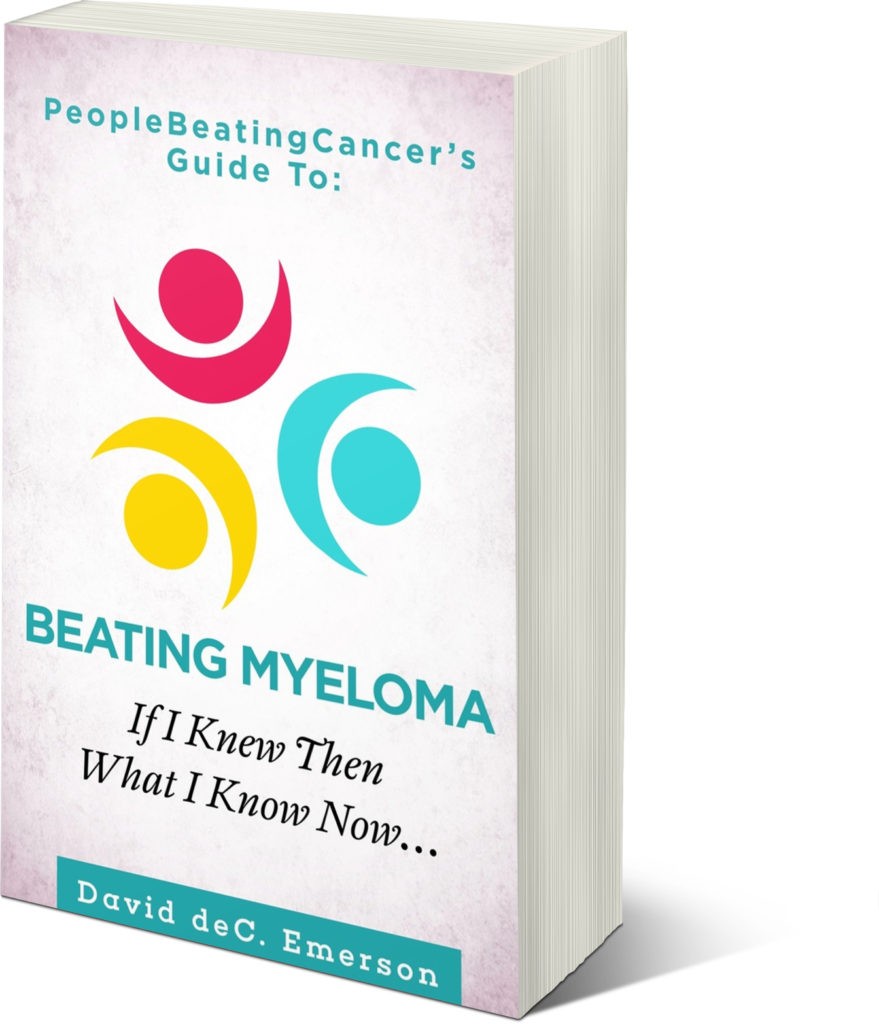
Recently Diagnosed or Relapsed? Stop Looking For a Miracle Cure, and Use Evidence-Based Therapies To Enhance Your Treatment and Prolong Your Remission
Multiple Myeloma an incurable disease, but I have spent the last 25 years in remission using a blend of conventional oncology and evidence-based nutrition, supplementation, and lifestyle therapies from peer-reviewed studies that your oncologist probably hasn't told you about.
Click the orange button to the right to learn more about what you can start doing today.
- You are here:
- Home »
- Blog »
- Multiple Myeloma »
- Relapsed/Refractory Myeloma- Four Prior Treatments
Relapsed/Refractory Myeloma- Four Prior Treatments

You are a relapsed/refractory myeloma survivor who has had four prior treatments. If you’re reading this post my guess is that you have been through induction therapy (RVD or RVDd), maybe an ASCT, possibly maintenance therapy and then one or more chemo cocktails after that.
My point is that you are running out of therapy choices and are learning about and considering either CAR-T therapy and/or teclistamab-cqyv (Tecvayli).
According to the articles linked and excerpted below, in order to be eligible for either/or CAR-T or Taclistamab, you need to have undergone one or more of the chemo regimens listed in the categories listed below.
- Immunomodulatory drugs. Thalidomide, lenalidomide (Revlimid), and pomalidomide (Pomalyst)
- Proteasome inhibitors. Bortezomib (Velcade), carfilzomib (Kyprolis), and ixazomib (Ninlaro)
- CD38 Monoclonal antibodies. Elotuzumab (Empliciti) and daratumumab (Darzalex)
- Immunotherapy. Isatuximab-irfc (Sarclisa)
- Nuclear export inhibitors. Selinexor (Xpovio)
Or to look at things a different way, in order to get here you have put your body through a lot of toxic therapy. And undergoing either CAR-T or Taclistamab, you will put your body through even more toxicity.
These newly approved therapies come with a host of side effects. See below. My research and experience has taught me that your best option lies in a practice called Pre-habilitation.
In effect you are getting in shape for CAR-T or Taclistamab. You are getting your body in shape for a therapy that has been shown to come with serious side effects.
Research shows that even modest pre-habilitation will improve your odds of a successful outcome. Okay, the photo in the upper left may be a bit of an exaggeration. 
However, the photo to the right is modest pre-habilitation. AKA stretching before some modest cardio in the form of walking or swimming.
To Learn More about Relapsed/Refractory Multiple Myeloma, read the posts linked below
- Relapsed, Refractory Multiple Myeloma- Therapy Options
- Relapsed/Refractory Myeloma- t11/14 enhances Ventoclax
- Relapsed Refractory Multiple Myeloma & The Elderly Patient
- Relapsed/Refractory Multiple Myeloma- Efficacy, Cost, AE’s
- Relapsed/Refractory Multiple Myeloma- Cytogenetic Testing
- Relapsed/Refractory Multiple Myeloma- Patient Preferences
- Curcumin, Doxorubicin Combo in Relapsed/Refractory
Have you undergone at least four different therapies for your multiple myeloma? Are you considering CAR-T cell therapy? Scroll down the page, post a question or comment and I will reply to you ASAP.
Hang in there,
David Emerson
- MM Survivor
- MM Cancer Coach
- Director PeopleBeatingCancer
FDA Approves BCMA-Targeted CAR T-Cell Therapy for Multiple Myeloma
“A type of immunotherapy called CAR T-cell therapy is now an option for some people with relapsed/refractory multiple myeloma. On March 26, the Food and Drug Administration (FDA) approved idecabtagene vicleucel (Abecma) for people with multiple myeloma that has not responded to or has returned after at least four different prior cancer treatments…
To make CAR T-cell therapies, a patient’s own T cells are collected, genetically engineered so they are better able to “see” and kill cancer cells, and then given back to the patient. With ide-cel, genetic engineering lets the CAR T cells “see” BCMA, a protein that’s present at high amounts in multiple myeloma cells. BCMA is found in a small subset of healthy white blood cells but not in other healthy cells…
What Are the Side Effects of Ide-cel?
Nearly all trial participants (99%) experienced a serious side effect. The most common side effects were fatigue, infections, and cytokine release syndrome.
The approval comes with a boxed warning (a notification of serious or life-threatening risks) for four treatment-related side effects:
- cytokine release syndrome
- hemophagocytic lymphohistiocytosis/macrophage activation syndrome (HLH/MAS)
- brain-related side effects (neurotoxicity)
- lower-than-normal number of blood cells (prolonged cytopenia)
| Side effects | Any reaction (mild to deadly) |
Serious reaction | Deaths |
| Cytokine release syndrome | 85% | 9% | 1 |
| HLH/MAS | 4% | 4% | 2 |
| Brain-related side effects | 28% | 4% | 0 |
| Prolonged thrombocytopenia | – | 49% | 0 |
| Prolonged neutropenia | – | 41% | 0 |
Carvykti Approval Marks Second CAR T-Cell Therapy for Multiple Myeloma
“Patients with advanced multiple myeloma now have a second option for CAR T-cell therapy, a type of personalized immunotherapy. On February 28, the Food and Drug Administration (FDA) approved ciltacabtagene autoleucel (Carvykti) for adults with multiple myeloma that is not responding to treatment (refractory) or has returned after treatment (relapsed).
Under the approval, ciltacabtagene autoleucel, also called cilta-cel, can be taken by people who have already received four or more lines of therapy (four prior treatments), including treatment with three major classes of multiple myeloma drugs
- an immunomodulating agent, (thalidomide, revlimid, pomalyst)
- a proteasome inhibitor, (velcade, kyprolis, ninlaro) and
- an anti-CD38 monoclonal antibody-
…“So having another therapeutic approach in our toolbox is so important,” Dr. Davies added. CAR T-cell therapy “works in a completely different way than our standard treatments and, therefore, it offers a different way of killing [drug] resistant myeloma cells, which really is the key,” she said.
But cost, availability, and the time it takes to manufacture the treatment are limiting factors for CAR T-cell therapy. Cilta-cel has a list price of $465,000 for a one-time infusion, although the final cost to a patient will depend on their insurance coverage…
Side Effects
Cilta-cel led to side effects that are typical for a CAR T-cell therapy, such as cytokine release syndrome, infections, and nerve problems like pain or tingling (neuropathy)…
| Side effect | Frequency |
|---|---|
| Cytokine release syndrome | 95% |
| Infections | 59% |
| Low blood platelet count | 41% |
| Low neutrophil count | 30% |
| Nerve problems | 26% |
| Low antibody levels | 12% |
Some side effects appeared days or weeks after the cilta-cel infusion. In addition, there were seven deaths attributed to the treatment…
FDA Approves Teclistamab-cqyv for Relapsed or Refractory Multiple Myeloma
“The FDA has granted accelerated approval to teclistamab-cqyv (Tecvayli) for adult patients with relapsed or refractory multiple myeloma who have received at least 4 prior treatments, including
- a proteasome inhibitor (PI),
- an immunomodulatory agent (iMID),
- and an anti-CD38 monoclonal antibody.1
Patients were heavily pretreated, with 78% of patients having received at least 4 prior lines of therapy. The median nuymber of prior lines of treatment received was 5 (range, 2-14). Notably, 76% of patients were triple-class refractory…
Fifty-four percent of patients who received teclistimab experienced serious adverse effects. Serious adverse reactions that occurred in more than 2% of patients included penumonia (15%), cytokine release syndrome (CRS; 8%), sepsis (6%), general physical health deterioration (6%), COVID-19 (6%), acute kidney injury (4.8%), pyrexia (4.8%), musculoskeletal pain (2.4%), and encephalopathy (2.4%).
Five percent of patients experienced fatal adverse reactions, which were due to COVID-19 in 1.8% of patients, pneumonia in 1.8%, septic shock in 0.6%, acute renal failure in 0.6%, and hemoperitoneum in 0.6%.
Only 1.2% of patients experienced toxicities that required permanent discontinuation of teclistamab. These patients experienced pneumonia and hypercalcemia. Seventy-three percent of patients required dose interruptions.
The toxicities that were most frequently experienced with the agent included pyrexia, CRS, musculoskeletal pain, injection site reaction, fatigue, upper respiratory tract infection, nausea, headache, pneumonia, and diarrhea. The most common grade 3 or 4 laboratory abnormalities included decreased lymphocytes, decreased neutrophils, decreased white blood cells, decreased hemoglobin, and decreased platelets.


